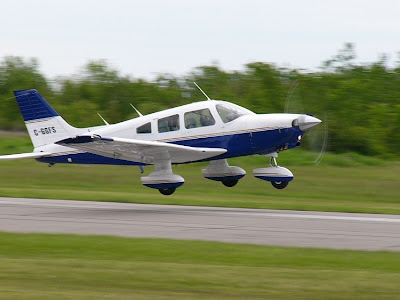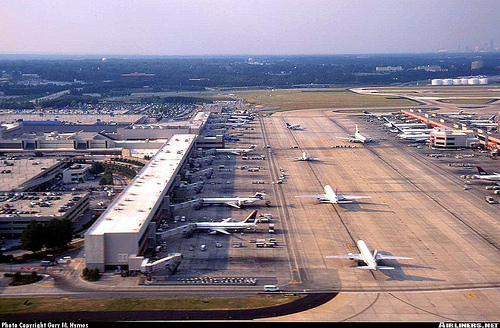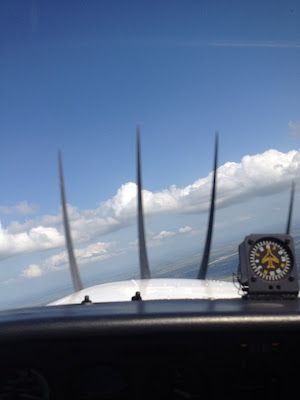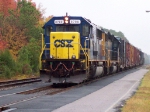 |
| Proper Sight Picture aka Center Mass |
This photo may not register with you at first, or it may if you're a seasoned marksman, or have ever received any instruction on how to properly engage and hit targets with an assault rifle. In the Army we call it aiming center mass, and we strive to keep this same "sight picture" every time we fire the weapon. Proper sight picture is one of the four fundamentals of marksmanship What exactly is a sight picture you ask? Well it is the point you at which you should to aim if you desire to place a round on target at a given distance. There is some variation to this depending on how close the target is because you must account for the trajectory of the round that you are firing as well as the weapon. For us we use M4A1 rifles or the M16A2/A4 manufactured by Colt which uses a 5.56mm round. Again there's a slight difference due to the M4 being shorter than it's big brother the M16 but I'll use the KISS (keep it simple stupid) philosophy here and exclude the details. However both weapons are highly effective in the right hands and just in case you're wondering 40 out of 40 is the best score you can receive, and I haven't qualified with anything less than a 38 in over four years. Sadly the "hawkeye" as we refer to it, perfect 40 out of 40, still eludes me to this day but I won't complain.
 |
| My M4A1 Rifle ACOG equipped |
Ok, Ok, Ok, I know you're probably saying "this is an aviation blog so why is he talking about weapons" but bear with me the connection has arrived.
 |
| Page about sight picture from the Airplane Flying Handbook |
And there it is straight from the FAA's "The Airplane Flying Handbook" which can be downloaded free online as a pdf or you can buy the app for 1.99 in the App store. This type of "sight picture" looks more like it right? If you're a student pilot like myself you may have seen this, but for the seasoned aviators out there this should've been a no brainer. Brad Tate who has an outstanding blog of his own titled "Airline Pilot Chatter" wrote about "sight picture" while explaining the differences in learning to land the 737-800 he now flies compared to the tried and true MD-80 that he had flown for years. You can read Brad's perspective here on his blog:
http://airlinepilotchatter.blogspot.com/2013/05/learning-to-land-737.html.
 |
| AA 737-800 in it's new livery on Short Final |
Today I learned first just how important it is to maintain a good sight picture during all phases of flight. It was also my first flight with Central Texas College (CTC) and my new instructor Clinton. Once again we bonded immediately much the same way that I did with my first instructor Matt from GFA. Since my last post I had flown an additional lesson in the C-172 just because I couldn't resist the urge to fly and every hour counts, but from today onwards I will be flying the Piper Archer II while working towards obtaining my private pilot's license (PPL). I'm already biased towards the Archer because standing at 6 feet and 4 inches tall space and comfort in general aviation aircraft is hard to come by. Besides I like the look and feel of the low wing design better anyway. The Archer provides that space and comfort and then some. The airplane may be old but it is safe and it gets the job done. Hopefully the new model with the G1000 glass cockpit will arrive soon. Until it does I look forward to using the Flight Training Device in our Flight Ops Simulation Center. CTC normally uses C-152s as its primary trainer during the PPL course, but due to my size I was approved to fly the Archer, which normally isn't available for students until the instrument course.
 |
| Aircraft I'll be flying the PA-28-181Piper Archer II |
 |
| Archer II Cockpit |
Yesterday was suppose to be my first flight with CTC and the weather was clear but I was unable to fly due to scheduling conflicts with another student. Not a problem since I was still on for today. A typical week for me consist of my flight block on Tuesdays and Thursdays totaling around 3 hours per week, but we are encouraged to sign up and fly as many days as possible which is how I ended up flying today. Even though I didn't fly my instructor still made good use of the time and took me out to the airplane and went over how to properly preflight the airplane and some other things from the Pilot's Operating Handbook. So when I came arrived today I was able to get straight to business and spend as much time in the air as possible. I arrived at our flight operations building at the airport, checked out the aircraft and immediately began to preflight the airplane. Soon after I was joined by my instructor who re-briefed me on what to expect during today's lesson. I'll spare you the details of the rest of the preflight, but the theme for today would make it's first appearance very early on in the lesson.
 |
| My gear contained in the flight bag |
 |
| Archer POH, get to know your aircraft |
Since it would be my first time flying the Archer we did some extra taxiing on the ground, and this was the first time my instructor would show me the proper "sight picture" in the Archer. Sight Picture and references are very helpful during taxi to ensure that we are tracking the center line of the taxiway at all times. For the aviation readers you all know why this is important and why it's good to develop that practice as a habit early on during training so that it becomes second nature when you move up to larger and larger aircraft. Just in case you're not what we refer to as an Avgeek (Aviation Geek) I'll explain further. Tracking the center line while taxiing on the ground keeps the wings of the airplane away from any potential obstacles. Whether it's another airplane parked on the ramp, taxiway signs that tell you where to go, or the many other things you find around airports.
 |
| B767 aligned perfectly from centerline taken from a CRJ-200 (http://www.flycrj.com/2010/04/25/how-to-taxi-jet-airplane/) |
 |
| Atlanta Hartsfield |
Today the wind was out of the north at 040 and 7 so we used runway 1 at KILE for takeoff. The same sight picture I had used earlier to taxi the airplane was used once again for the takeoff roll and we shortly after we were off. Immediately after liftoff my instructor had me climb to pattern altitude and make a turn for the practice area to the South East while climbing to 4,500 feet. Too easy, as we say in the military, and there I was with the kid in the candy store look once again enjoying the flight. During the climb Clinton would point out references to use on the airplane to establish the desired attitude without an over reliance on instruments. It'd didn't take long to reach my assigned altitude and after leveling off we went on to cover some pretty standard maneuvers which included climbs, descents, and shallow, medium, and steep turns in both directions. Those same reference points on the airplane were used to adjust the airplane as necessary again with out using the instruments during the maneuvers. Anyone see a trend developing?
.JPG) |
| C-172 Sight Picture during a level shallow turn |
Why is not solely using the instruments important? That's because all PPL training is done under VFR (Visual Flight Rules) conditions, and you must learn to scan for other traffic as well as make the correct inputs as a pilot to ensure the safety of yourself and others. I was told to use roughly a 90/10 rule. Meaning to look outside of the airplane 90% of the time and inside at the instruments 10% of the time. Avoiding fixating on any one single thing is a skill I would consider as a basic principle of flying, much like the marksmanship principles I mentioned earlier. Clinton's method of instruction is perfect for me because he presents the information in a clear way that's easy to understand, and provides an environment in the airplane that allows me to fly and feel things for myself.
After performing those maneuvers it was time to turn back and head for the airport. KILE is a little different because we use a Right Traffic Pattern when runway 1 is in use and a Left Traffic Pattern when Runway 19 is in use. So after descending to pattern altitude we entered the traffic pattern on the 45 on the downwind leg. Once again that all important sight picture and references was laid out clear and concise and is extremely important during the landing phase of flight. Using my reference points, obtained during the lesson, I guided the Archer around the pattern for two touch and go landings with the third landing being a full stop. A quick taxi back and shut and another 1.2 hours was added in the log book.
 |
| UAL 787 on takeoff |
I only have at least 1,497.1 more hours to go until I can even begin to think about the references I would use to find right sight picture with one of those. The FAA requires 1500 flight hours to qualify for an Airline Transport license beginning in august of this year. Undoubtedly the road will be long but so far enjoyable it has been enjoyable. My dream is becoming a reality day by day step by step, and I realize how lucky I am to have even flown and airplane at all. Flying is not something I will ever take for granted. Not many people in this world get to wake up each day and do something that they love to do. No matter the circumstances a positive attitude is key to the proper "sight picture" in this thing we call life.
 |
| Three flights scheduled next week starting 2pm Monday as show in flight schedule pro |












